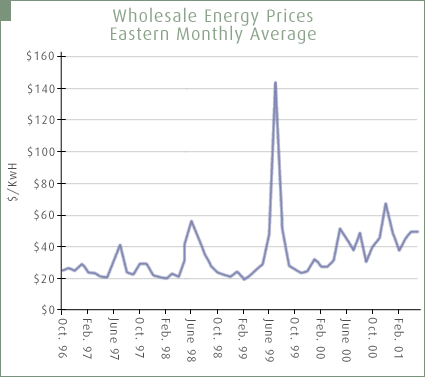 |

Wholesale prices have remained stable in the Pennsylvania-New Jersey-Maryland
Interconnection (PJM). The price rise in the summer of 1999 can be attributed
to extra seasonal demand and to distribution problems, which were affecting the
Midwest that year. However, this price spike behaved as market economists
would predict and returned to previous levels after the extra demand
dissipated.


As of January 1, 2000, Pennsylvania became one of the first states in the
country to let consumers choose their electricity supplier. Even though
wholesale prices fluctuate according to supply and demand, retail customers
enjoy price caps, and residential and commercial customers get an 8 percent
rate reduction. According to the PA Electric Shopping Statistics web site, as
of April 2001, 787,846 residential, commercial and industrial customers had
chosen their own supplier (about 15% of eligible customers). Pennsylvania is
often heralded as one of the most successful cases of utility deregulation, but
the measure of the program really depends upon how the market works once price
caps are lifted in 2006.
This Pennsylvania customer has chosen an alternate energy supplier - one that's
more environmentally oriented than other companies. As you can see, this
customer's power bill went down by about $8 from 2000 to 2001. Her rate was
stable for a year at around 7 cents per kilowatt-hour -- the only reason her
total bill fluctuated was because of her usage patterns. The price stability
is because price caps are in place in Pennsylvania until 2006.



home - california - my bill - new business - regulation - the future - new york times reports
video - interviews - glossary - discussion - synopsis - press - tapes & transcripts - credits
FRONTLINE - wgbh - pbs online
power lines photo ©2001 entropy media/images
web site copyright WGBH educational foundation
|  |